The death toll in Hawaii’s wildfires rose to 99 and could double over the next 10 days, the state’s governor said Monday, as emergency personnel painstakingly scoured the incinerated landscape for more human remains.
Last week’s inferno on the island of Maui is already the deadliest US wildfire in a century.
But Governor Josh Green said more fatalities are certain, as emergency responders with cadaver dogs work their way through hundreds of homes and burned-out vehicles.
“The updated number of 99 confirmed people have passed,” he told CNN on Monday.
He added: “It will go up very significantly… Over the course of the next 10 days, this number could double.”
The historic Maui coastal town of Lahaina was almost destroyed by the fast-moving blaze last week, with survivors saying there had been no warnings.
Green said rescue workers were finding between 10 and 20 dead bodies each day, with only a small portion of Lahaina near the waterfront searched so far.
The number of people still missing is down to around 1,300, although delays restoring cell phone communications have made it difficult for residents who fled to reconnect.
“Our hearts will break beyond repair, perhaps, if that means that many more dead. None of us think that, but we are prepared for many tragic stories,” he told CBS earlier.
The town, which served as the Hawaiian kingdom’s capital in the early 19th century, was home to around 12,000 residents, as well as a bustling tourist street packed with shops and restaurants.
Now, “there’s nothing to see except full devastation,” said Green, who has visited the smoldering streets of rubble and ash multiple times.
The intensity of the fire and scale of the destruction have made identification of human remains difficult, with some corpses disintegrating as they are uncovered by searchers.
Police are encouraging those with missing relatives to give DNA samples that might speed up the process.
“This is an amazingly devastating fire and the conditions… are extraordinarily difficult to work through,” Jeremy Greenberg, a Federal Emergency Management Agency official, told a press briefing Monday.
Abysmal
The wildfire is the deadliest in the United States since 1918, when 453 people died in Minnesota and Wisconsin, according to the nonprofit National Fire Protection Association.
Questions are being asked about authorities’ preparedness and response to the catastrophe.
Some fire hydrants ran dry in the early stages of the wildfire as a result of the “intense operations and water usage” by firefighters, deputy US fire administrator Tonya Hoover said.
A class-action lawsuit has been filed against Hawaiian Electric, the state’s biggest power firm, claiming the company “inexcusably kept their power lines energized during forecasted high fire danger conditions.”
Hawaiian Electric said in a statement that the company does not comment on pending litigation, and noted that the cause of the fire has not yet been determined.
Whatever sparked the terrifying inferno, a collision of circumstances – including a churning hurricane off the coast – meant that it spread very quickly.
Maui suffered numerous power outages during the crisis, preventing many residents from receiving emergency alerts on their cell phones.
No sirens sounded, and many people in Lahaina learned about the blaze from neighbors running down the street or seeing it for themselves.
Attempts to allow residents back into Lahaina descended into chaos Monday, as a placard system identifying those permitted to travel was suspended after barely an hour.
“The miscommunication is abysmal — people are very angry and frustrated, and this is getting worse,” said Stephen Van Bueren, 42, a local church pastor who waited for more than an hour to get a placard, without success.
“They are restricting everyone, they are blocking access. Why are they keeping people away?”
Aloha spirit
Maui’s fires follow other extreme weather events in North America this summer, with record-breaking wildfires still burning across Canada and a major heat wave baking the US southwest.
Europe and parts of Asia have also endured soaring temperatures, with major fires and floods wreaking havoc.
Scientists say human-caused global warming is exacerbating natural hazards, making them both more likely and more deadly.
In Lahaina, a few thousand buildings were damaged or destroyed as the fire tore through the town, according to official estimates, wreaking more than $5 billion in damage.
Hundreds of hotel rooms are being made available for free to victims, with long-term rehousing options using Airbnb vacation homes also being explored, said Green.
Officials on Monday downplayed fears about more incoming adverse weather. Tropical Storm Greg is expected to pass a few hundred miles south of Maui later this week.
Meanwhile, communities have been launching their own initiatives to cope with the tragedy.
Volunteers at the University of Hawaii culinary school in Kahului, 30 miles (50 kilometers) east of Lahaina, cranked out thousands of fresh meals on Sunday for those affected.
“Some of our chefs have lost their homes (in the fire), and they’re right here right alongside us cooking for their community,” Sheldon Simeon, a Maui-based chef known nationally as an ambassador of Hawaiian cuisine, told AFP.
“Just gives you a sense of what the ‘aloha’ spirit is,” Simeon said.
Previous devastating fires:
Australia
In “Black Saturday” in Australia’s Victoria state, 173 people were killed, in Australia’s worst bushfire on February 7, 2009.
Whole towns and more than 2,000 homes were destroyed.
Greece in 2007 and 2018
In Greece’s worst-ever fire disaster, 103 people died when wildfires swept through homes and vehicles in the coastal town of Mati near Athens in July 2018, leaving only charred remains.
The majority of the victims were trapped by the flames as they sat in traffic jams while trying to flee. Others drowned while trying to escape by sea.
In 2007, a 12-day inferno starting in late August killed at least 67 people and destroyed 800 homes across the southern Peloponnese peninsula.
The flames engulfed most of the region’s olive groves. The Aegean island of Evia was also badly affected.
In all 77 people died that summer due to fires.
Algeria in 2021 and 2022
More than 90 people, including 33 soldiers, were killed in dozens of wildfires in Algeria in August 2021.
The government blamed arsonists and a blistering heatwave for the blazes, but experts also criticised authorities for failing to prepare for the annual wildfire season.
In August 2022, massive blazes killed 37 people over several days in northeastern El Tarf province, near the border with Tunisia.
More than 10,000 hectares (25,000 acres) went up in smoke in El Kala National Park, a UNESCO-listed heritage spot famous for its rich marine, dune, lake and forest ecosystems.
2018: California
On November 8, 2018 at dawn, California’s deadliest modern fire broke out in the town of Paradise, some 240 kilometres to the north of San Francisco, killing 85 people over more than two weeks.
It burned more than 62,000 hectares of land and reduced more than 18,800 buildings to ashes.
An investigation found that high tension electricity wires sparked the fire.
The Camp Fire is likely the most deadly fire in the United States for a century; the Cloquet Fire in 1918 in the northern state of Minnesota killed around 1,000.
Portugal in 2017
The deadliest wildfires in Portugese history broke out in the central Leiria region during a heatwave in June 2017 and burned through hills covered with pine and eucalyptus trees for five days.
Many of the 63 people who died became trapped in their cars while trying to escape.
In October, a new series of deadly fires broke out in northern Portugal, killing another 45 people as well as four in neighbouring Spain. Those fires were chiefly blamed on arsonists.
Source: AFP







